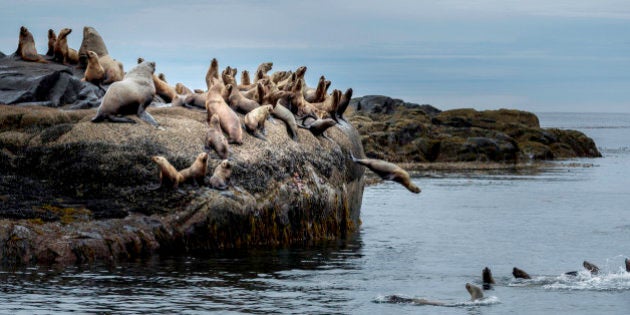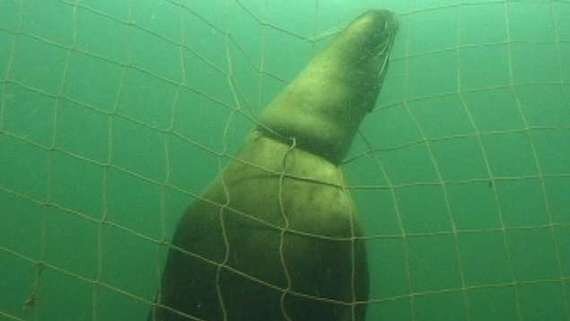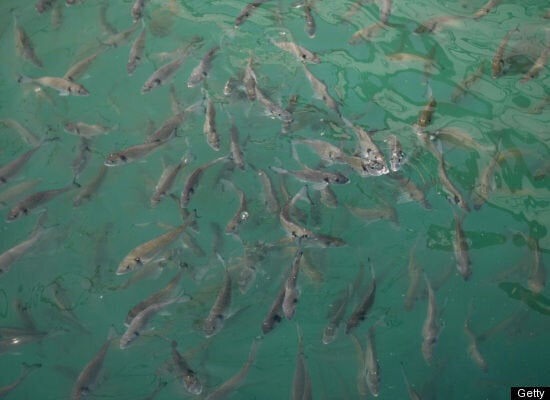
British Columbians were shocked to learn of the recent slaughter of 15 California sea lions by salmon farmers on the west coast of Vancouver Island. But the killing of marine mammals at open-pen salmon feedlots is nothing new. And the cumulative death toll is horrifying.
The most recent killings, disclosed on March 30 by salmon farming giant Cermaq, took place in December of last year at their Binns Island salmon farm north of Tofino.
The 15 California sea lions, lured by the presence of tonnes of densely packed young salmon, were shot by Cermaq staff for posing "an ongoing threat to the safety of the farm staff, fish and net pens."
Environmentalists have been quick to point out the folly of allowing what are essentially factory farms in some of our most sensitive and cherished marine ecosystems.
"Clayoquot Sound is a UNESCO Biosphere Reserve. It's a recognition of just how special a place this is", said Clayoquot Action's Bonny Glambeck. "Yet even here, wildlife is not safe from Norwegian-owned industry."
Marine mammals, seals and sea lions in particular have paid a terrible price at the hands of salmon farmers.
We hear a lot about the risks of open-pen salmon feedlots to the survival of our wild salmon, but much less about other collateral damage the industry causes. Marine mammals, seals and sea lions in particular have paid a terrible price at the hands of salmon farmers.
Department of Fisheries and Oceans (DFO) statistics show that since 1990, the B.C. industry has shot and killed more than 7,000 of our marine mammals: almost 6,000 harbour seals, 1,200 California sea lions and 363 endangered Steller sea lions.
"Marine mammal interactions" (a.k.a. deaths) are a well-known and inevitable consequence of open-pen salmon farming. It's hard not to see how putting large numbers of slow-moving, artificially fattened fish directly into the habitat of hungry sea lions is flawed by design.
So the shooting of seals and sea lions is an accepted industry practice, not just in B.C., but around the world. Outrage also swept across the U.K. recently following revelations that hundreds of seals were being killed by Scottish salmon farmers.

Shooting "nuisance sea lions" is only one of the ways feedlots take a toll on our marine mammals.
It is not uncommon for them to get caught in the nets that enclose the pens and drown. Seal and sea lion entanglements are such a problem for the industry that they have even forced Marine Harvest to withdraw applications for sustainability certification for some of their feedlots.
Tragically, whales can also die from entanglement at salmon farms. In 2013, the body of a young humpback whale was reported at the Ross Point salmon farm near Tofino. Cermaq claimed it had died elsewhere and simply drifted into the enclosure.
The DFO claimed evidence for drowning in the nets inconclusive, but it would not be the first humpback to die at a B.C. salmon farm -- nor at feedlots in other countries. A humpback tangled in salmon feedlot rigging has also been caught on video.
Sadly, there appears to be little consequence to salmon farmers for these deaths, apart from the bad public relations they cause. In 2013, another Norwegian company, Grieg Seafoods, managed to negotiate its way out of charges of nine counts of unlawfully destroying marine mammals.
In that incident, 65 California sea lions and one harbor seal perished after becoming entangled in nets at three of their farms within a six-month period.
Both government and industry will downplay the recent killings, pointing to reductions in the number of reported shootings in the last several years. But the numbers are curious.
From 1990 to mid-way through 2011, reports averaged about 360 seals or sea lions killed per year -- almost one per day. Then, virtually overnight, the reported numbers plummeted to an average of less than one a month.
Did salmon farmers come up with some new technology to keep sea lions away, somehow managing to roll it out in the space of a couple months to over a hundred feedlots, owned by multiple companies, located in remote areas scattered across the province? Or is there a simpler explanation?
Salmon farmers are given a blanket authorization to kill "problem" seals and sea lions, with the requirement to report the shootings after the fact. From 2011 on (about the same time as the precipitous drop in reported killings), this license to kill was included as part of their aquaculture license, removing separate licencing under Canada's Marine Mammal Regulations. In other words, they shoot first, report later.
Perhaps salmon farmers just stopped reporting all of the seal and sea lion shootings? They certainly would have motive. It is an industry that faces almost constant controversy over its environmental practices, and marine mammal deaths simply add to their public relations problem.
It would also be exceptionally easy to get away with. In the remote bays along B.C.'s coast where most feedlots are located, there are rarely others around to witness a shooting.
The majority of what we know about what goes on at salmon farms is based on what salmon farmers tell us goes on.
And there is evidence that shootings have gone unreported by salmon farmers in the past. In 2010, videos emerged showing salmon farm feed bags containing sea lion carcasses weighed down with rocks that had washed ashore in Clayoquot Sound. The bags were identical to ones stacked on the structure of a nearby salmon farm. Then there was the mass grave of sea lions discovered nearby.
But it is not just self-reporting of sea lion shootings that we need to be concerned about. For sea lice counts, the use of antibiotics and toxic chemicals, incidental catch of other wild fish species, escapes of Atlantic salmon and, most troubling of all, disease outbreaks that endanger wild salmon, the majority of what we know about what goes on at salmon farms is based on what salmon farmers tell us goes on.
Given the grave risks to our coastal ecosystem that open-pen salmon feedlots present, the reliance on self-reporting is deeply concerning. Where it becomes downright frightening is when the federal government cedes its authority to salmon farmers on decisions that could have truly catastrophic consequences for our coast.
Last year, the Federal Court struck down licence conditions that allowed salmon farmers to transfer disease-infected salmon smolts into our coastal waters.
But the federal government has teamed up with the salmon farmers to appeal that decision. If they are successful, it will mean salmon farmers will decide for themselves if their virus-laden farmed salmon pose a risk to our wild salmon.
The appeal is a particularly reckless form of deregulation that we came to expect in the Harper era. We expect more from the Trudeau government. The new Liberal Fisheries Minister, Hunter Tootoo has the power to halt the appeal, but to date he has not done so.
With the consequences of global warming changing our coastal ecosystem at a frightening pace, every species, from the top to the bottom of the food chain, is now at risk. Seal and sea lion populations may be considered stable at the moment, but we have entered an unprecedented time in the history of our oceans. We just don't know what comes next.
What we do know is that regulating salmon farmers by the honour system will not protect our wild salmon, nor the orcas, wolves, bears, eagles, seals and sea lions that depend upon them. The only way to ensure the killing stops and our wildlife is protected is to remove salmon feedlots from our coast.
Photo credit: Twyla Roscovich/coastcast.org
Follow HuffPost Canada Blogs on Facebook
MORE ON HUFFPOST:
